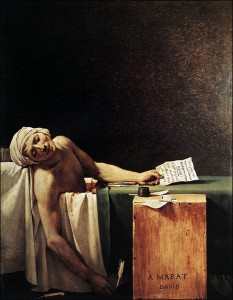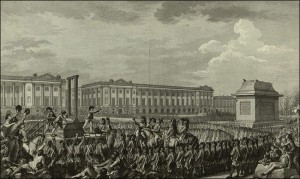All links are to Wikipedia entries.
Government, Politics, and War:
- January 21: Louis XVI of France is executed after being found guilty of treason by the National Convention.
- January 22: Louis XVI’s brother, the Comte de Provence, who fled France in 1791, proclaims himself regent for his 7-year-old nephew Louis-Charles, son of the executed king, who is proclaimed Louis XVII by royalist émigrés.
- February 1: The French Republic declares war on England and the Netherlands.
- March 5: French troops are defeated by Austrian forces and Liège is recaptured.
- March 7: The French Republic declares war on Spain.
- April 15: The first Bank of England £5 note is issued in response to the need for smaller denomination banknotes to replace gold coin during the French Revolutionary Wars (previously the smallest note issued had been £10).
- June 2: The Girondins are overthrown in France.
- July 13: Radical Jacobin Jean-Paul Marat is assassinated by Girondist sympathizer Charlotte Corday, who stabs him in his bath. She not only holds him responsible for the September Massacres, but believes Marat to be the center point for everything that is threatening a true Republic, and believes that his death will be the death of violence throughout the nation. Instead her action leads to reprisals that ultimately bring on the Reign of Terror. Corday is executed 4 days later.
- September 5: The Reign of Terror begins in France. The National Convention is taken over by radical Jacobins who embark on a systematic and lethal repression of perceived enemies of the Revolution. Within the next 12 months, as many as 40,000 executions will take place.
- September 30: 11 people killed and 45 injured in the Bristol Bridge Riot, a protest against the levying of tolls on the bridge as well as plans to demolish several houses near the bridge to create a new access road.
- October 16: After being tried and found guilty of treason by the National Convention, Queen Marie Antoinette of France is executed.
- October 24: The French National Convention adopts the Republican Calendar, with twelve 30-day months beginning with the Year One of the Revolution (September 22, 1792).

The Death of Marat by Jacques-Louis David. (Click on image to see a larger version and to read more about it.)
Art, Architecture, and Design:
- Lansdown Crescent is completed in Bath by architect John Palmer.
- January 1: Venetian painter Francesco Guardi dies at age 80.
- September 5: The Louvre Palace in Paris is opened to the public as a museum.
- October: Jacques-Louis David paints The Death of Marat, one of the most famous images of the French Revolution.
Music:
- Niccolò Paganini debuts as a violin virtuoso at age 11.
- Joseph Haydn completes his String Quartets, Opp. 71 & 74 “Apponyi”, and Variations in F Minor.
Science and Industry:
- Thomas Minton establishes his ceramics manufactory, Thomas Minton and Sons, in Stoke-upon-Trent, Staffordshire.
- The Plymouth Gin Distillery begins production
Natural History and Exploration:
- July 20: Scottish explorer Alexander Mackenzie‘s 1792–1793 Peace River expedition to the Pacific Ocean reaches its goal at Bella Coola, British Columbia, making him the first known person to complete a transcontinental crossing of northern North America.





